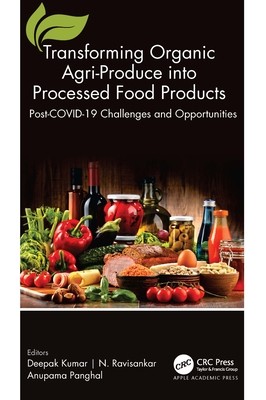
- We will send in 10–14 business days.
- Publisher: Apple Academic Press
- ISBN-10: 1774911922
- ISBN-13: 9781774911921
- Format: 15.6 x 23.4 x 2.5 cm, hardcover
- Language: English
- SAVE -10% with code: EXTRA
Transforming Organic Agri-Produce Into Processed Food Products (e-book) (used book) | bookbook.eu
Reviews
Description
The demand for organic foods has been expanding at a steady rate, and during the COVID-19 epidemic, it increased even further, as consumers regarded these foods as healthier and better for immunity than conventional foods. This book covers all aspects of organic agriculture and how to transform organic agriculture into processed foods for global demand after the COVID-19 pandemic.
The chapters discuss the post-COVID-19 impacts on organic agriculture and processed food, as well as recent milestones in basic and applied organic agriculture and organic food product sectors. Current issues such as international policies, intellectual property rights protection, the global scenario of organic certification, regulatory framework, and hindrances for farmers and organic food value chain participants are briefly discussed. In addition, valuable chapters related to the production of nutraceutical organic foods like soy protein hydrolysate, fox nuts (Euryale ferox), and Red Dacca bananas are incorporated into the volume.
This volume, Transforming Organic Agri-Produce into Processed Food Products: Post-COVID-19 Challenges and Opportunities, will be a useful resource not only for students, teachers, researchers, and those in industry, but also for those interested in the fields of organic agriculture, food technology, food safety, regulatory sciences, organic food business management, marketing, and entrepreneurship development. This book may also help those who want to transform their existing business into the organic food sector.
EXTRA 10 % discount with code: EXTRA
The promotion ends in 19d.06:44:37
The discount code is valid when purchasing from 10 €. Discounts do not stack.
- Publisher: Apple Academic Press
- ISBN-10: 1774911922
- ISBN-13: 9781774911921
- Format: 15.6 x 23.4 x 2.5 cm, hardcover
- Language: English English
The demand for organic foods has been expanding at a steady rate, and during the COVID-19 epidemic, it increased even further, as consumers regarded these foods as healthier and better for immunity than conventional foods. This book covers all aspects of organic agriculture and how to transform organic agriculture into processed foods for global demand after the COVID-19 pandemic.
The chapters discuss the post-COVID-19 impacts on organic agriculture and processed food, as well as recent milestones in basic and applied organic agriculture and organic food product sectors. Current issues such as international policies, intellectual property rights protection, the global scenario of organic certification, regulatory framework, and hindrances for farmers and organic food value chain participants are briefly discussed. In addition, valuable chapters related to the production of nutraceutical organic foods like soy protein hydrolysate, fox nuts (Euryale ferox), and Red Dacca bananas are incorporated into the volume.
This volume, Transforming Organic Agri-Produce into Processed Food Products: Post-COVID-19 Challenges and Opportunities, will be a useful resource not only for students, teachers, researchers, and those in industry, but also for those interested in the fields of organic agriculture, food technology, food safety, regulatory sciences, organic food business management, marketing, and entrepreneurship development. This book may also help those who want to transform their existing business into the organic food sector.


Reviews